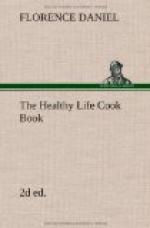III.—SAVOURY DISHES.
The recipes following are intended to be used as substitutes for meat, fish, etc.
The body needs for its sustenance water, mineral salts, [Footnote: I allude to mineral salts as found in the vegetable kingdom, not to the manufactured salts, like the ordinary table salt, etc., which are simply poisons when taken as food.] fats and oils, carbo-hydrates (starch and sugar), and proteids (the flesh and muscle-forming elements). All vegetable foods (in their natural state) contain all these elements, and, at a pinch, human life might be supported on any one of them. I say “at a pinch” because if the nuts, cereals and pulses were ruled out of the dietary, it would, for most people, be deficient in fat and proteid. Wholewheat, according to a physiologist whose work is one of the standard books on the subject, is a perfectly-proportioned, complete food. Hence it is possible to live entirely on good bread and water.
Nuts are the best substitute for flesh meat. Next in order come the pulses. After these come wholewheat and unpolished rice. Both nuts and pulses contain, like flesh meat, a large quantity of proteid in a concentrated form. No one needs more than 1/4 lb. per day, at most, of either. (Eggs, of course, are a good meat substitute, so far as the percentage of proteid is concerned.)
1. ALMONDS, ROASTED.
Take any quantity of shelled almonds and blanch by pouring boiling water on them. The skins can then be easily removed. Lay the blanched almonds on a tin, and bake to a pale yellow colour. On no account let them brown, as this develops irritating properties. To be eaten with vegetable stews and pies. (That is, with any stew or pie which contains neither nuts nor pulse.)
2. CHESTNUTS, BOILED.
An excellent dish for children and persons with weak digestive powers. The chestnuts need not be peeled or pricked, but merely well covered with cold water and brought to the boil, after which they should boil for a good half hour. Drain off the water and serve hot. They may also be boiled, peeled, mashed and eaten with hot milk.
3. CHESTNUT SAVOURY.
Boil for 15 minutes. Shell. Fry in a very little nut fat for 10 minutes. Barely cover with water, and stew gently until tender. When done, add some chopped parsley and thicken with chestnut flour or fine wholemeal. For those who prefer it, milk and dairy butter may be substituted for the water and nut fat.
4. CHESTNUT PIE.
1 lb. chestnuts, 1/2 lb. tomatoes, short crust.
Boil the chestnuts for half an hour. Shell. Skin the tomatoes and cut in slices. Well grease a small pie-dish, put in the chestnuts and tomatoes in alternate layers. Cover with short crust (pastry recipe No. 3) and bake until a pale brown. Serve with parsley, tomato, or white sauce.
5. CHESTNUT RISSOLES.




